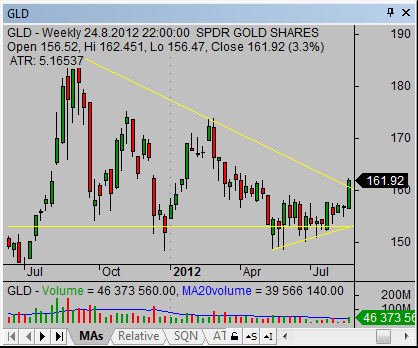How to Find The Best Gold ETF
Post on: 22 Апрель, 2015 No Comment

Golds history as a store of value goes back before the time of written records, but its still an asset/investment class of significant importance in todays market. As a relatively scarce metal, gold has always been held in esteem and investors (as well as merchants and normal citizens) have long used gold as a means of safeguarding buying power or offsetting the risks of inflation and financial turbulence [for more gold news and analysis subscribe to our free newsletter ].
For quite a while, investors options were limited when it came to gold. Jewelry and numismatic gold (coins) were pretty much always an option, but buyers faced high bid/ask spreads and the costs and hassles of storing that gold safely. Bullion gold became a viable legal option again in 1975, and investors have also been able to access the futures markets to replicate some of the benefits of owning gold. Now, though, investors have several options among ETFs, including those that hold real bullion and those that hold financial derivative (futures) contracts.
Price Drivers
While every market is ruled by supply and demand, its a bit more explicit in the case of gold. Gold pays no dividends and produces no earnings or cash flow (though gold miners can and do). That is a problem for some investors, though the extent to which “fair multiples” change over a market cycle highlight that earnings and cash flow dont guarantee anything.
Gold prices are most significantly influenced by market perceptions of inflation and market confidence in general. There have been many studies of golds role as an inflation hedge, and the data is decidedly mixed (due in part, probably, to inconsistencies in how inflation has been measured over time). Nevertheless, whenever governments make inflationary moves (monetary stimulus, for instance), gold often does well [see also Investing In Gold: The Definitive Guide ].
Gold also moves on turbulence and instability. Nations rise and fall, but gold is still gold. Turbulence, uncertainty, and confidence are hard to measure – so much so that some investors and market observers actually reverse the ratio and use golds performance as a measurement of market sentiment.
Where Gold ETFs May Fit
The proper role of gold in a portfolio is very much up for debate. Golds advocates argue that everybody should own gold (and some say you should own a lot); others believe the right allocation of gold is “none.” A middle path holds that investors should consider allocating about 5% to 15% of their portfolio to precious metals (including gold).
Its difficult to slot gold into a typical “aggressive/conservative” metric. Since gold produces no income, some would say its an aggressive holding for retired investors, while others would say the vulnerability of retired persons to inflation makes not holding gold the aggressive move. Of course, theres also the trading/speculative angle – if you think gold is heading higher, you should own it (and this attitude/approach is generally seen as aggressive).
Leaving aside the questions of golds place in a portfolio, gold prices do tend to be more volatile than the norm.
Factors To Consider
When considering a gold ETF. the first question is whether you wish to own a fund based on gold bullion itself or gold prices as reflected in futures prices. Using futures results in higher costs (contracts have to be bought and sold as they expire) and tracking error from spot prices, but they can outperform in certain circumstances. Investors can also consider ETFs focused on gold miners. though these stocks (and ETFs) have become less popular and less correlated to gold prices in recent years.
As always, investors should also remember to examine factors like net asset value, portfolio turnover, fund expenses and trading volume.
The Contenders
The biggest names among gold ETFs include SPDR Gold Trust (GLD ), iShares COMEX Gold Trust (IAU ), and the Physical Swiss Gold shares (SGOL ), all three of which own physical bullion. The PowerShares DB Gold Fund (DGL ) is the largest futures-based gold ETF, while ProShares and DB both offer liquid funds that short gold and/or use leverage to magnify results.
Returns are quite consistent across the group – SPDR Gold Trust and COMEX Gold trust both have roughly 74% returns over three years, while the short ETFs/ETNs have lost almost 80% of their value over that time. The largest futures-based fund (DB Gold Fund) lags the bullion ETFs a bit, due to the costs of the contract rollovers and higher expense ratio [see also Ending QE Could End Gold’s Bull Run ].
Peoples Choice
The SPDR Gold Trust and iShares Gold Trust are hands down the most popular gold ETFs. In fact, all of the other gold ETF assets combined are less than half the assets of IAU which, in turn, is about 15% the size of GLD. Volume largely follows this pattern, though the short ETFs and ETNs trade more often than their net asset value may suggest.
Expense Considerations
Because theres so little active management to the physical gold ETFs, theyre also the cheapest. Theres not much to business here other than buy gold, store gold (and pay for that safe storage), and pay for auditing, compliance, and shareholder service expenses. As a result, SPDR Gold Trust offers a 0.4% expense ratio, with the COMEX Gold Trust even cheaper at 0.25%.
Don’t forget to subscribe to our free daily commodity investing newsletter and follow us on Twitter @CommodityHQ .
Disclosure: No positions at time of writing.














